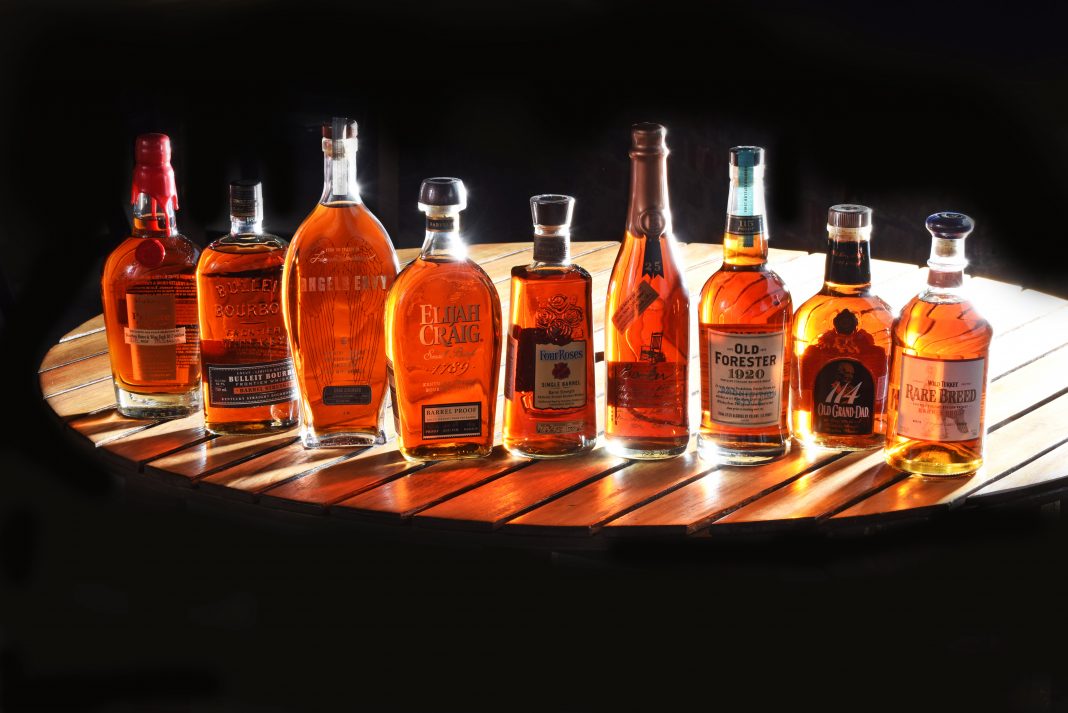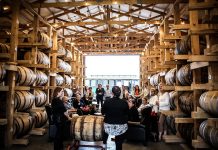A few years before he passed away in in 2004, I had the distinct privilege to spend a morning with legendary Jim Beam Master Distiller Booker Noe at his home in Bardstown. He was a man big in stature, over six feet tall, and even bigger in his enthusiasms.
Noe showed me the smokehouse in his back yard where he cured and aged his own country hams. A still functional antique beaten biscuit machine was one of his most prized possessions. I believe he said it had been his grandmother’s. (In case you didn’t know, he is the grandson of Jim Beam, himself.) But naturally, what he loved to talk about the most was the bourbon he introduced to the sipping public in 1987 – Booker’s.
After our tour, we headed to the kitchen where he had a bottle of Booker’s, a couple of glasses, and a bottle of Evian water waiting on the round oak table. We sat, and he proceeded to carefully share instructions and the secret to getting the most from his high proof, unfiltered whiskey.
Instructions? What’s to know about taking a sip out of a glass? Quite a lot if the drink is barrel proof, which — in the case of Booker’s — could be 125 proof (62.5 percent alcohol by volume) and up.
For comparison, know that most beer weighs in at an average of 4 to 6 percent alcohol by volume (ABV). Wine is usually somewhere between 12 and 15 percent. The vast majority of whiskeys, including bourbon, are bottled between 40 and 50 percent ABV. But a select few bourbons (about three dozen out of hundreds of brands) tip the scales at what is known as barrel or cask strength, more than 55 percent ABV — or between 110 and 135 proof.
In other words, proceed with caution.
When it was released in 1987, Booker’s was intended to bring back a bourbon style that had been popular before Prohibition. The proof would not be adjusted with distilled water when the whiskey came out of the barrel. Hence, the terms “barrel proof” or “cask strength.” The bourbon also would not be chill filtered before bottling, a process used for most bourbons which removes molecules that cause the whiskey to go cloudy when water or ice is added. (Some elements of flavor may also get left behind.)
Noe was also given free rein to choose a small number of select barrels he thought would be the most flavorful: the “honey barrels” to batch into Booker’s bottlings. So, not only was the barrel strength style reintroduced but the new term “small batch” arrived in the industry.
All these years later, I honestly don’t remember the glassware we used that morning. It may have been small brandy snifters, or they could have simply been rocks glasses. This was before the tulip shaped Glencairn glasses developed for Scotch tasting caught on with bourbon drinkers, but I do remember admiring the deep reddish-gold color of the whiskey and Noe telling me to add “just a splash” of the Evian. It was important that the water be chlorine free and that we add it before nosing and sipping.
When you nose a very high proof whiskey, all you are going to get is a snoot full of hot alcohol. Go ahead and sniff a flamethrower if this is your idea of a good time. You can mitigate the heat by nosing, turning your head to blow the alcohol through your mouth and out of your sinuses, and then nosing a second time. It was on my second nosing that the rich layers of vanilla and caramel, toffee and spices, and fruits and nuts (and perhaps even some leather, tobacco and toasted marshmallows) became apparent.
I added the splash of water, and the bourbon blossomed in the glass with successive waves of flavors appearing on the palate the way the best fireworks keep changing from one color to the next as they explode before finally fading and disappearing in a sprinkling of sparks. That’s exactly what my sip of Noe’s bourbon at his oak kitchen table was like.
By the way, it was 10:30 in the morning.
Today, Booker’s is by no means the only barrel strength brand on the market. Most of the big Kentucky distillers have high proof expressions (versions) of some of their flagship labels. Some are annual releases with relatively limited availability, although you can often find those sold by the glass in bars and restaurants with excellent bourbon selections.
Many proofs vary by release date, but here are a few examples of cask strength bourbons and what you might expect from a sip of each after you add a little water:
Angel’s Envy Cask Strength (1230) – Rich caramel bordering on molasses with cocoa and pecans. Notes of leather and dried fruit.
Bulleit Barrel Strength (125.40) – Bananas Foster with berries and a touch of sweet mint.
Elijah Craig Small Batch (130.60) – Fruit bomb! Ripe apples, pears, berries and apricots with vanilla-caramel sauce.
Maker’s Mark Private Select (1110) – Toffee, apples, pecans, with a sweet and smoky note. (Bacon?!) Oaky, but not bitter.
Old Forester 1920 (1150) – Apricots, berries, and ripe apples with toffee and nuts.
Old Grand-Dad 114 (1140) – Dried cherries, orange peel, dates. Caramel backed up by vanilla and cocoa.
Wild Turkey Rare Breed (116.80) – Honeyed vanilla, brown sugar, caramel, cherries, dates and sweet tobacco.
The most varied cask strength bourbons come from Four Roses. These are exclusively bottled as Private Selections for bars, restaurants, liquor stores and whiskey appreciation societies. Four Roses has ten different recipes, made from two mash bills — one 75% corn, 20% rye, 5% malted barley and the other 60% corn, 25% rye, 5% barley — and five yeast strains. These are described as lightly fruity, slightly spicy, richly fruity, herbal, and floral. Over the years I managed to collect bottles of each, although I am now missing two since I have a silly habit of drinking the bourbons I buy.
Why would you want to risk breathing fire by sipping from these highly flammable bottles? Two reasons – Flavor and Value.
As I mentioned about Booker’s, the high proof, combined with between six and eight years of aging, means the flavors are concentrated in the bottle. Add water — or a cube of ice — to let them loose.
That seemingly expensive bottle ($50-$80) delivers a lot more drinks than the bottle a distiller has diluted to adjust the proof to 80, the minimum allowed by law for bourbon. Why not dilute it yourself to your taste? Just remember what another bourbon legend, Pappy Van Winkle, said about proof: “Why pay for water?” F&D
Originally published in the Fall 2018 issue of Food & Dining Magazine

























